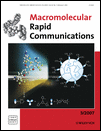Selective Enzymatic Grafting by Steric Control
Abstract
Enzymatic grafting of caprolactone was carried out from poly[styrene-co-(4-vinylbenzyl alcohol)] containing 10% hydroxyl functional monomer and compared with the grafting of vinyl acetate. A molecular weight increase due to the grafting of polycaprolactone was observed by size exclusion chromatography. Closer investigation of the grafting density by 1H NMR revealed an upper limit to the amount of grafting of about 50–60% of the pendant hydroxyl groups leaving unreacted hydroxyl groups on the polymer backbone available for subsequent reactions. The higher grafting density (95%) obtained with vinyl acetate suggests that this is not due to limited accessibility of the backbone but sterical constrains. Moreover, the grafting action of polycaprolactone seems to be a combination of grafting from by monomer initiation and grafting onto by transesterification of polycaprolactone.





